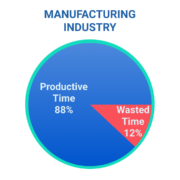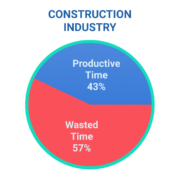Wasted time in construction
is out of control


…
The construction industry is in desperate need of digitalisation.
Not only has the productivity been declining for the last decades, but also the wasted time is spinning out of control and on top of that, the industry and its buildings are responsible for nearly 40% of the global energy consumption, the worldwide carbon emissions, and the overall produced waste.
The construction industry employs about 7 percent of the world’s working-age population and is one of the world economy’s largest sectors, with $10 trillion spent on construction-related goods and services every year.
But the industry has an intractable productivity problem.
Other sectors have transformed themselves and their productivity performance. The productivity in the construction industry however has been declining for the last decades. Research by McKinsey&Company compares construction productivity to manufacturing productivity since the early nineties. While manufacturing has nearly doubled their productivity, construction has actually been decreasing.
“The Construction Industry Institute (CII) published a report in 2004 comparing wasted time vs productive time in the manufacturing and the construction industry. 88% of time in manufacturing was found to be productive (value added) vs only 43 % of time spent in construction. This report demonstrates that more than 50% of time spent on construction sites is waste (non value added).”


If we look for reasons behind this enormous waste of time, we can’t ignore the fact that the construction industry has been very slow to adopt digital technology. The MGI Industry Index 2015 shows that the construction industry is currently among the least digitalised industries, only slightly better than the hunting industry.
Due to that, the continuous use of digital information along the entire process chain falls significantly behind other industry domains. All too often, valuable information is lost because information is still predominantly handed over in the form of drawings, either as physical printed plots on paper or in a digital but limited format. Such disruptions in the information flow occur across the entire lifecycle of a built facility: in its design, construction and operation phases as well as in the very important handovers between these phases.
The construction industry is extremely fragmented. Many different players are involved in one project, from design to construction to facility management and ultimately the demolition of the building. Digital is the lever for business transformation, allowing the industry to do things better.
The future is to adopt digital solutions and services transcending this fragmentation and to ensure a truly connected end-to-end value chain.